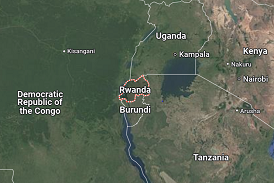Following the confirmation of the deadly Marburg virus disease (MVD) on 27 September 2024 by the Rwanda Ministry of Health, the World Health Organization (WHO) says the neighboring east African countries countries – Tanzania, Uganda and Democratic Republic of Congo (DRC) are at risk.
“There is a risk of this outbreak spreading to neighboring countries since cases have been reported in districts located at the borders with the Democratic Republic of the Congo, the United Republic of Tanzania, and Uganda,” WHO said.
“Contact tracing is underway, with about 300 contacts under follow-up as of 29 September 2024. One contact travelled internationally. They remained healthy, completed the monitoring period and did not present with any symptoms. The source of the infection is still under investigation and additional information will be provided when available,” it said.
“There is a risk of this outbreak spreading to neighboring countries since cases have been reported in districts located at the borders with the Democratic Republic of the Congo, the United Republic of Tanzania, and Uganda,” it said.
As of 29 September 2024, a total of 26 confirmed cases, including eight deaths have been reported. The cases are reported from seven of the 30 districts in the country. Among the confirmed cases, over 70% are healthcare workers from two health facilities in Kigali. The patients are being cared for in hospitals. Contact tracing is underway, with 300 contacts under follow-up.
MVD is a highly virulent disease that can cause haemorrhagic fever and is clinically similar to Ebola diseases. Marburg and Ebola viruses are both members of the Filoviridae family (filovirus). People are initially infected with Marburg virus when they come into close contact with Rousettus bats, a type of fruit bat, that can carry the Marburg virus and are often found in mines or caves.
Several outbreaks of MVD have previously been reported from countries neighbouring Rwanda, including the Democratic Republic of the Congo, Uganda and the United Republic of Tanzania. The most recent outbreaks were reported in Equatorial Guinea and the United Republic of Tanzania between February and June 2023. The affected region in the United Republic of Tanzania was the Kagera region, which borders Rwanda. Additional countries that previously reported outbreaks of MVD in the African Region included Angola, Ghana, Guinea, Kenya, and South Africa.
This is the first time MVD has been reported in Rwanda. The Government of Rwanda is coordinating the response with support from WHO and partners. There is currently no available treatment or vaccine for MVD. This is why it is important for people showing Marburg-like symptoms to seek care early for supportive treatment which can improve patient survival. WHO assesses the risk of this outbreak as very high at the national level, high at the regional level, and low at the global level.
Marburg virus spreads between people via direct contact (through broken skin or mucous membranes) with the blood, secretions, organs or other bodily fluids of infected people, and with surfaces and materials (e.g. bedding, clothing) contaminated with these fluids. Healthcare workers have previously been infected while treating patients with suspected or confirmed MVD. Burial ceremonies that involve direct contact with the body of the deceased can also contribute to the transmission of Marburg virus.
The incubation period varies from two to 21 days.
Illness caused by Marburg virus begins abruptly, with high fever, severe headache and severe malaise. Severe watery diarrhoea, abdominal pain and cramping, nausea and vomiting can begin on the third day. Although not all cases present with haemorrhagic signs, severe haemorrhagic manifestations may appear between five and seven days from symptoms onset, and fatal cases usually have some form of bleeding, often from multiple areas. In fatal cases, death occurs most often between eight and nine days after symptom onset, usually preceded by severe blood loss and shock. There is currently no available treatment or vaccine for MVD. Some candidate vaccines are currently under development.

